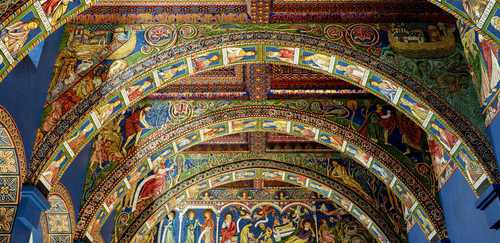Rome. The frescoes in the chapter house of the monastery of Sigena (Huesca), in Aragon, made in 1200, considered one of the greatest monuments of European Romanesque art made by an international group of artists, is the subject of the new documentary by Jesús Garcés Lambert, titled Sigena’s dream (2021). By Romanesque we mean the style that emerged in Europe between the 11th and 13th centuries, when the architectural and artistic grandeur of ancient Rome was recovered.
The film “deals with the journey of a hero who achieves the dream of returning a lost heritage to the world,” shares the Mexican filmmaker in conversation with The Day. That dreamer is Juan Emilio Naya, a pharmaceutical executive and former NASA astrophysicist, who is also the protagonist and co-producer of the film along with Xavier Atance.
For 12 years, since 2007, Juan digitally and physically rebuilt the chapter house, which caught fire in 1936 – just after the civil war began -, being reduced to fragments and its splendid colors twisted. The 400 black and white photographs that the architect Josep Gudiol took in the room as part of a study, just two months before the fire, were essential for its reconstruction.
Garcés Lambert has lived in Rome since 1996 and enjoys international fame, which he has forged by renewing the art documentary, as in his successful film Caravaggio: the soul and the blood (2018). The filmmaker considers that “the reappropriation of memory is one of the film’s greatest contributions, despite being a conflictive evocation that shows that the wounds of the Spanish civil war are still open”.
The investigation includes the hypothetical recovery of the iconography and the original color, dominated by blues, greens and pinks. The film weaves together the history of the murals with interviews with some of the greatest experts on the subject, such as Manuel Castiñeiras, Jordi Camps, Neil Stratford and Katheleen Doyle, among others. Also participating are the designer Albert Burzon, who carried out the virtual reconstruction, as well as the artists who made the pictorial reproduction and the Mudejar coffered ceiling.
The monastery was founded in 1188 by the queen of Aragon Sancha de Castilla, who, when she was widowed, chose it as her place of retirement. It was a lonely place, ideal for recollection and as remote as it is today, located 250 kilometers west of Barcelona and 100 from Zaragoza. The murals, as was customary at the time, were inspired by the illustrations in the manuscripts and were made by a multicultural team of artists, as happened in the Palatine Chapel in Palermo, completed half a century earlier and with which stylistic links have been identified. Sancha’s daughter, Constanza, was the queen of Sicily.
As in Palermo, in Sigena the European, Byzantine and Muslim traditions were also unified. Sigena was born at the time when the kingdom of Jerusalem fell, after the defeat of the Third Crusade (1187), reaching Europe not only works of art, but also artists. Sancha must have conceived of the chapter house as an evocation of the Holy Land. Professor Jaroslav Folda, an expert on the art of the Crusades, states in the film that “the Sigena chapter house is perhaps the first great work in the West to be influenced by the art of the Crusades.”
He considers that the Old Testament scenes, made on the spandrels of the arches, must have been painted by an English artist. Walter Oakeshott identified him in his seminal 1972 book, among the Winchester Bible artists, the so-called Blademaster Morgan, Preserved in the Morgan Library in New York. While the New Testament cycle of the walls and the genealogy of Christ with the 70 portraits located in the intradoses of the five arches must have been made by a Byzantine artist, identified with the Salterio de Melisenda (1132–1143), a luxury manuscript of excellent quality commissioned by the eldest daughter of the king of Jerusalem, whose illustrations coincide not only with the style, but also with the order of the scenes in Sigena, which made it possible to complete some losses. Finally, the polychrome and gold coffered ceiling was made by a Mudejar artist.
For now, the space where the replica of the room can be rebuilt has not been defined. According to Garcés Lambert, “Juan hopes it will be in Sigena, although the political will of the government of Aragon does not yet exist”.
Contentious restitution
Castiñeiras explains in the film that those responsible for the fire were the Catalan anarchist militias, which were burning the churches on Aragonese land. “It may surprise us, but there are so many monuments in the history of art that have been burned by revolutionary causes, like the Jacobins in Paris, who destroyed most of the Gothic works.”
Burned for two days, the murals were restored, detached and taken to the National Museum of Art of Catalonia (MNAC), which has the largest collection of Romanesque painting in the world. This 12th century collection was formed between 1920-1923 after the removal of the frescoes from the Romanesque churches of the Pyrenees to safeguard them from looting. But those of Sigena, which are one of the greatest jewels of the enclosure, are very different not only because of the region of belonging and finesse, but above all because they arrived in very different conditions, opening one of the longest and most mediated litigation of Spanish heritage .
According to the old Aragonese newspaper Herald –Which has followed the dispute for at least half a century–, “the murals were taken to Barcelona for their temporary restoration, but they never returned to Sigena. The Huesca deputation claimed them since 1939 ”.
The abandonment into which the convent fell after the civil war later led to the plundering and illegal sale of the rest of its rich and exquisite heritage. Its status as a National Monument (1923) allowed after 20 years of litigation to declare void in 2015 the sale of the hundred works of art that the San Juanist nuns made between 1983 and 1994 by the court number 1 of Huesca to the MNAC and the Generalitat of Catalonia.
Half of the hundred pieces in question were returned in 2016 by the MNAC, while the Museum of Lleida in Catalonia did not, forcing the Civil Guard to break into the museum by court order in December 2017, recovering them by force.
The resolution of the wall paintings is pending. At the beginning of 2016, the provincial court of Huesca reiterated the request for return in October 2020. The litigation was suspended last September pending the ruling of the Supreme Court. The MNAC has argued in its favor the impossibility of transporting the paintings, because their fragility would damage them, in addition to the inadequate conditions of conservation and exhibition.
In such terms, the film was presented in Aragon and Catalonia and, given the tense moods, both parties feared that it would be boycotted. “When they saw it, they understood that there was no political purpose, but merely artistic, and they were impressed by the beauty of the reconstructed paintings and their history, which generated a conciliatory attitude. It was exciting”.
The film will be part of the international screenings of the Cervantes Institute that will include its exhibition in Mexico soon.
–


